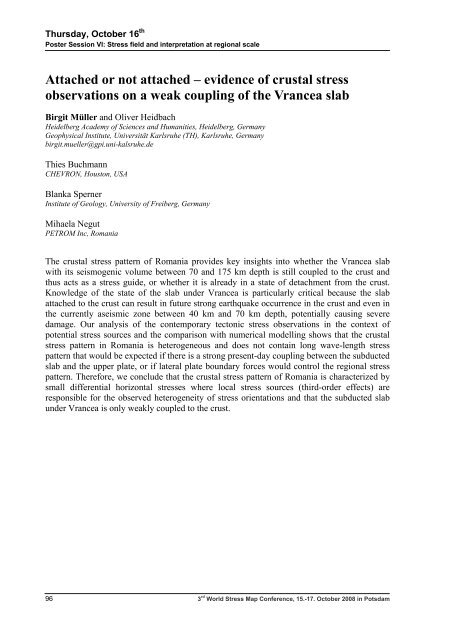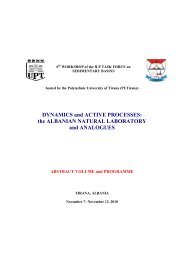World Stress Map Conference - International Lithosphere Program ...
World Stress Map Conference - International Lithosphere Program ...
World Stress Map Conference - International Lithosphere Program ...
Create successful ePaper yourself
Turn your PDF publications into a flip-book with our unique Google optimized e-Paper software.
Thursday, October 16 th<br />
Poster Session VI: <strong>Stress</strong> field and interpretation at regional scale<br />
Attached or not attached – evidence of crustal stress<br />
observations on a weak coupling of the Vrancea slab<br />
Birgit Müller and Oliver Heidbach<br />
Heidelberg Academy of Sciences and Humanities, Heidelberg, Germany<br />
Geophysical Institute, Universität Karlsruhe (TH), Karlsruhe, Germany<br />
birgit.mueller@gpi.uni-kalsruhe.de<br />
Thies Buchmann<br />
CHEVRON, Houston, USA<br />
Blanka Sperner<br />
Institute of Geology, University of Freiberg, Germany<br />
Mihaela Negut<br />
PETROM Inc, Romania<br />
The crustal stress pattern of Romania provides key insights into whether the Vrancea slab<br />
with its seismogenic volume between 70 and 175 km depth is still coupled to the crust and<br />
thus acts as a stress guide, or whether it is already in a state of detachment from the crust.<br />
Knowledge of the state of the slab under Vrancea is particularly critical because the slab<br />
attached to the crust can result in future strong earthquake occurrence in the crust and even in<br />
the currently aseismic zone between 40 km and 70 km depth, potentially causing severe<br />
damage. Our analysis of the contemporary tectonic stress observations in the context of<br />
potential stress sources and the comparison with numerical modelling shows that the crustal<br />
stress pattern in Romania is heterogeneous and does not contain long wave-length stress<br />
pattern that would be expected if there is a strong present-day coupling between the subducted<br />
slab and the upper plate, or if lateral plate boundary forces would control the regional stress<br />
pattern. Therefore, we conclude that the crustal stress pattern of Romania is characterized by<br />
small differential horizontal stresses where local stress sources (third-order effects) are<br />
responsible for the observed heterogeneity of stress orientations and that the subducted slab<br />
under Vrancea is only weakly coupled to the crust.<br />
96 3 rd <strong>World</strong> <strong>Stress</strong> <strong>Map</strong> <strong>Conference</strong>, 15.-17. October 2008 in Potsdam




